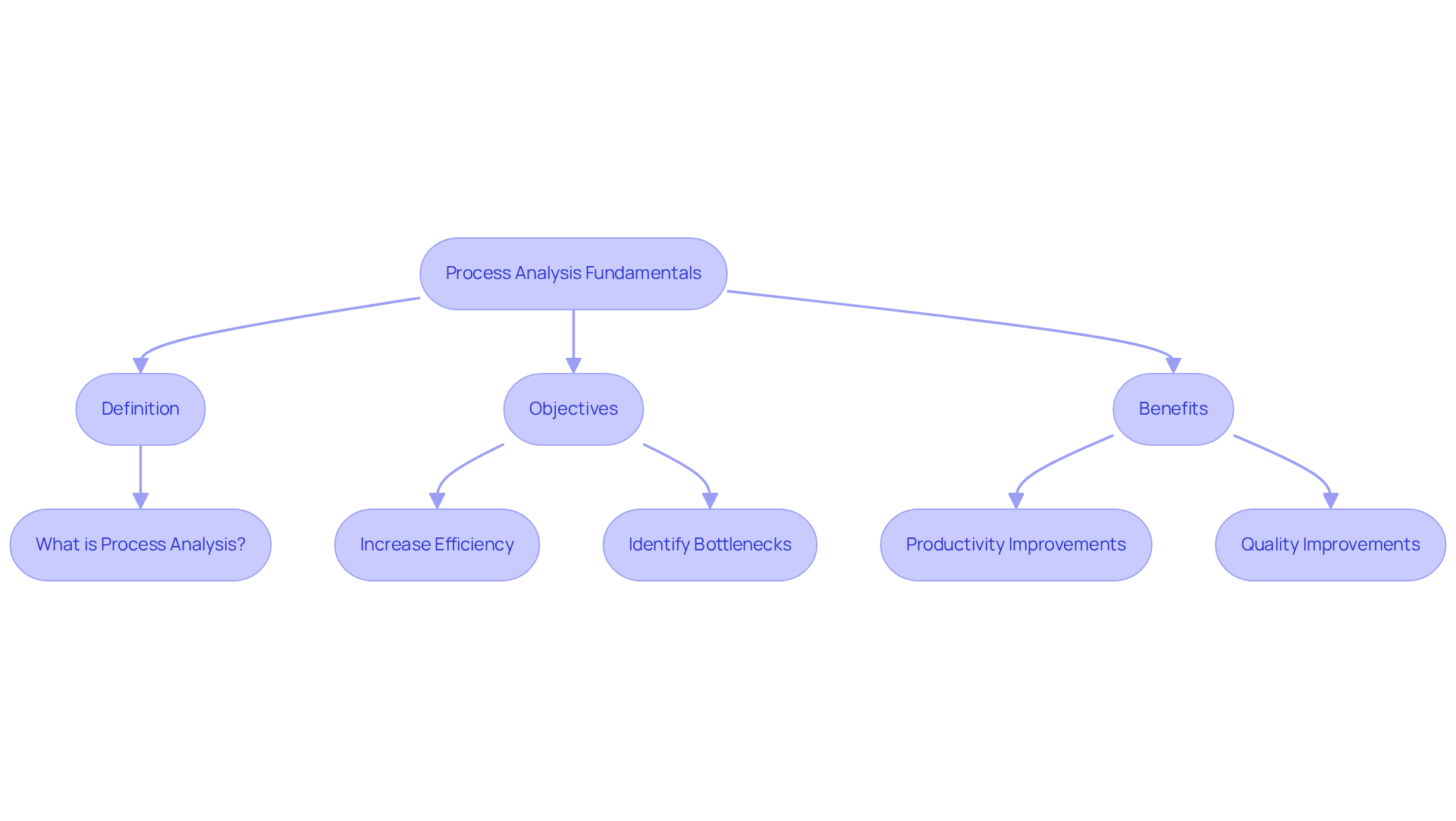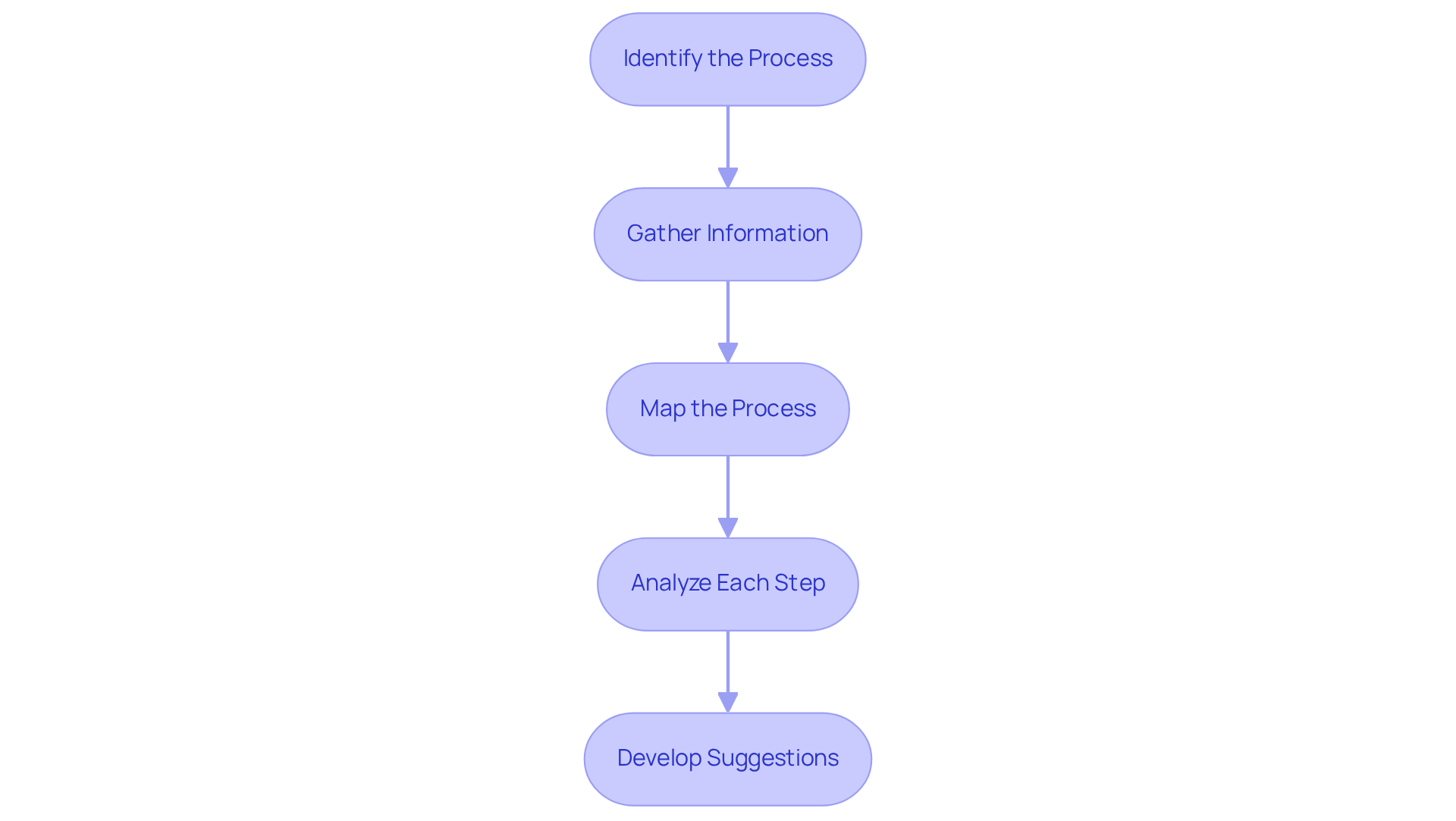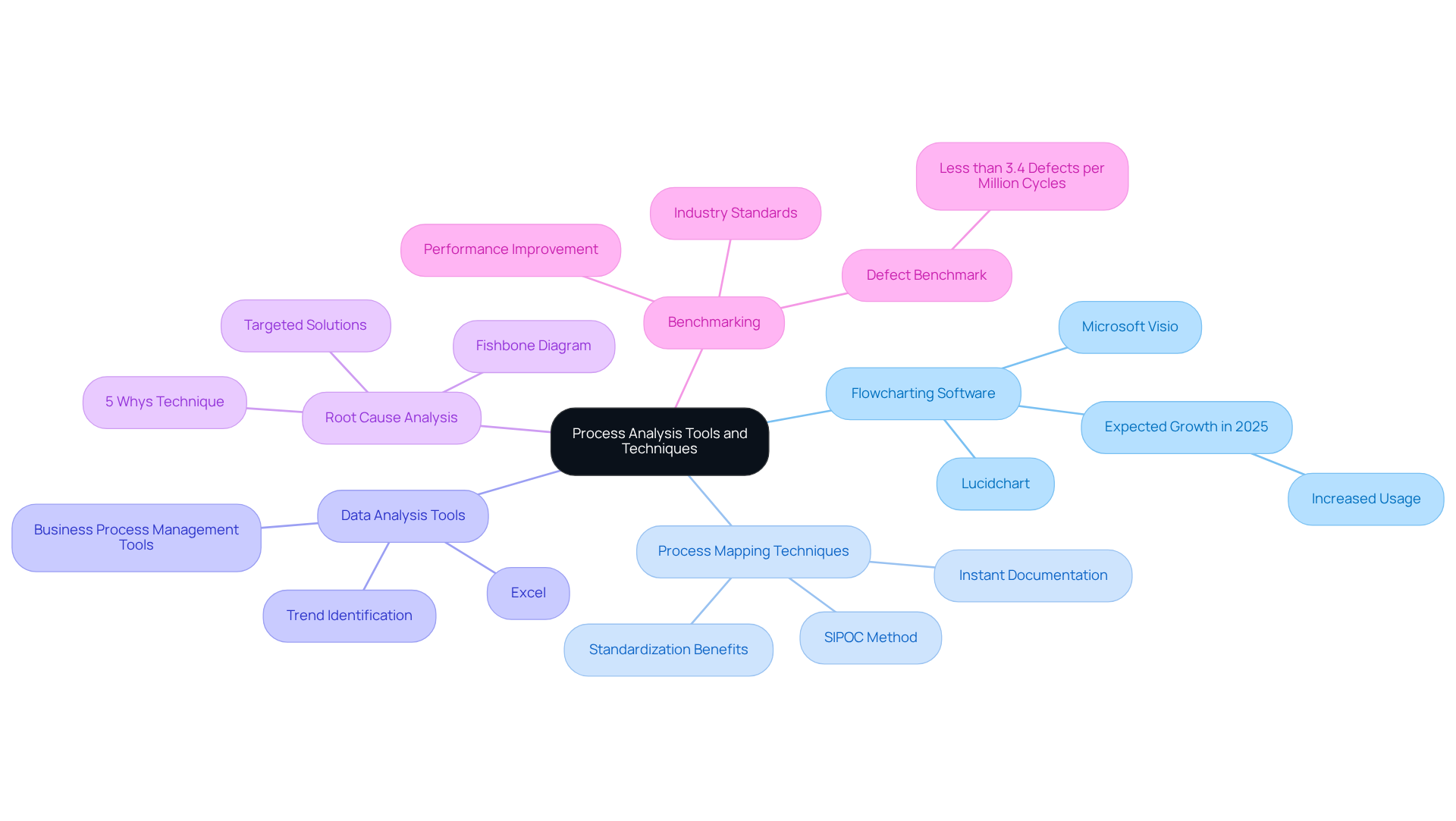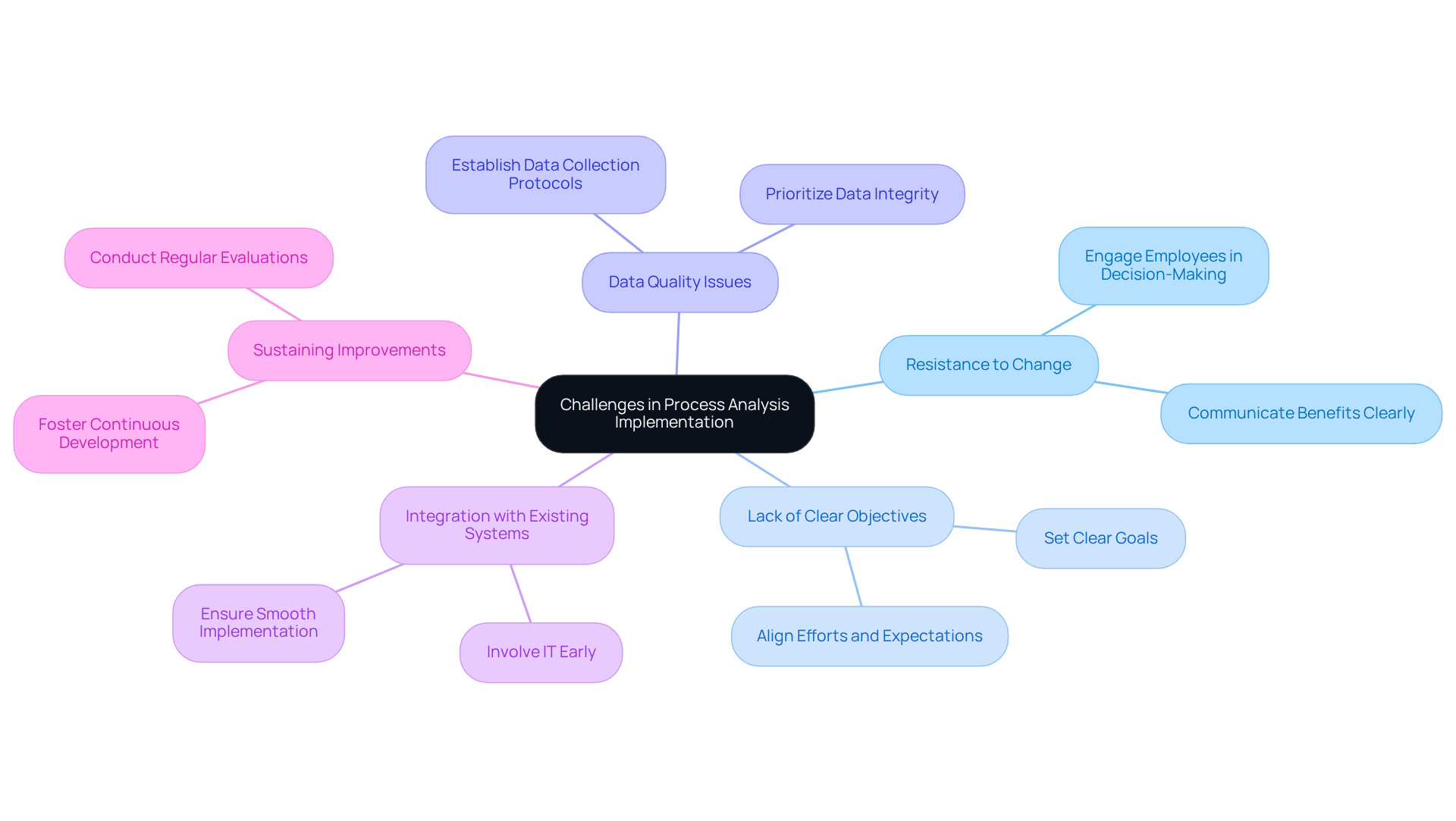
Automation and Documentation
|
October 17, 2025
|
Define Process Analysis: Steps for Operations Managers
Overview
You might be wondering what process analysis is all about. Well, it’s essentially a systematic look at workflows to spot inefficiencies and boost operational efficiency. The main goal here? To kick those bottlenecks to the curb and ramp up productivity!
The article lays out some specific steps for effective process analysis, like:
- Mapping out processes
- Using handy tools such as flowcharting software
Plus, it shines a light on the impressive productivity gains you could see—potentially cranking up output by as much as 50% by 2025 if you dive into thorough evaluations. Isn’t that something to think about?
Key Highlights:
- Process analysis involves examining workflows to identify areas for improvement, enhancing operational efficiency.
- The main objective is to eliminate bottlenecks and inefficiencies, potentially increasing productivity by 50% by 2025.
- Effective process evaluation can lead to productivity boosts of 15-30% for knowledge workers and 30-50% for back-office staff.
- Steps for effective process analysis include identifying the process, gathering information, mapping the process, analysing each step, and developing suggestions for improvement.
- Tools for process analysis include flowcharting software, process mapping techniques like SIPOC, data analysis tools, root cause analysis methods, and benchmarking.
- Challenges in implementation include resistance to change, lack of clear objectives, data quality issues, integration with existing systems, and sustaining improvements.
- Involving employees in decision-making and establishing clear communication can significantly enhance the success of change initiatives.
Introduction
You might be wondering why understanding the intricacies of process analysis is so important for operations managers. Well, if you're looking to boost efficiency and productivity in your organization, you’re in the right place! By breaking down workflows and spotting areas that need a little TLC, businesses can unlock some serious performance gains and smooth out those pesky operational bottlenecks.
But here’s the kicker: with all that potential for increased efficiency, how do you actually implement these analyses effectively? What strategies can you use to tackle common hurdles and ensure everything goes off without a hitch?
Let's dive into this together!
Understand Process Analysis Fundamentals
Have you ever thought about how methodical evaluation can really help businesses? It’s all about breaking down operations into their key parts to see what’s working and what could use a little TLC. This structured technique isn’t just a buzzword; it’s a way for organizations to gain insights into their workflows and pinpoint areas that are ripe for improvement. Let’s dive into some key aspects:
- Definition: So, what exactly is process analysis? To define process analysis, you need to take a close look at workflows to spot opportunities for enhancement. Big names like Cognizant and IBM are all about this practice, showing that it’s a smart move for any organization.
- Objectives: The main goal here is to ramp up operational efficiency. By identifying those pesky bottlenecks, redundancies, and inefficiencies that slow things down, businesses can really boost their performance. Looking ahead to 2025, organizations that really get into comprehensive procedure examination can expect some serious improvements. BPM initiatives are projected to ramp up productivity by a whopping 50%! Plus, staff can save an average of 240 hours a year just by adopting efficient BPM practices. That’s a lot of time saved!
- Benefits: Now, let’s talk benefits. Effective procedure evaluation can lead to increased productivity, cost savings, and better quality outputs. For example, BPM projects can boost productivity by 15-30% for knowledge workers and even more—30-50%—for back-office staff. And get this: BPM tools can cut down manual errors by 48% and enhance quality by 80%! Understanding these basics is crucial for operations managers, as it sets the stage for meaningful improvements that align with what the organization aims to achieve. A golden rule in workflow evaluation? Always consult with subject matter experts instead of making assumptions from a distance. This ensures that your evaluation is grounded in real-world insights. As W. Edwards Deming famously put it, "If you can't articulate what you are doing as a series of steps, you don't know what you're doing.

Define the Steps for Effective Process Analysis
To define process analysis effectively, you might be wondering where to start. Let’s break it down into some simple steps:
- Identify the Process: First things first, clearly define the specific workflow or operational procedure you want to analyze. This foundational step helps to define process analysis, setting the stage for a focused examination.
- Gather Information: Next, collect comprehensive data on the current operation, including inputs, outputs, and the sequence of activities. Interacting with colleagues who are engaged in the activity can offer valuable perspectives and context. With SowFlow, you can create user guides that outline these methods, ensuring that all team members have instant access to the necessary information.
- Map the Process: Now, let’s dive into creating a visual representation using flowcharts or diagrams. This mapping aids in understanding the flow of activities and highlights potential bottlenecks that can significantly impact efficiency. SowFlow's documentation tools can help in updating these visuals effortlessly, keeping them relevant as procedures evolve.
- Analyze Each Step: Here’s where the magic happens. To identify inefficiencies or areas for improvement, you should evaluate every component of the process to define process analysis. Look for redundancies, delays, and unnecessary steps that might hinder productivity. Research shows that almost 30% of the typical workday is devoted to activities that do not further company goals—yikes! This highlights the necessity for comprehensive evaluation. Using SowFlow can simplify this evaluation by offering immediate documentation and insights.
- Develop Suggestions: Finally, drawing from your evaluation, recommend practical modifications to improve the procedure. This could involve streamlining steps, reallocating resources, or implementing new technologies. With SowFlow, you can swiftly revise your documentation to incorporate these changes, ensuring that your group is always aligned and informed, ultimately decreasing the necessity for unnecessary meetings.
So, what do you think? Ready to dive in and make your process analysis more effective?

Utilize Tools and Techniques for Process Analysis
You might be wondering how to define process analysis even better, right? Well, several tools and techniques can really amp up your game, especially when you pair them with SowFlow's innovative documentation solutions.
Let’s start with Flowcharting Software. Applications like Lucidchart and Microsoft Visio are your go-to for creating visual representations of processes. These tools not only help you spot inefficiencies but also make communication a breeze among team members. In 2025, we're expecting the use of flowcharting software in workflow mapping to skyrocket, as organizations realize just how important it is to visualize those complex workflows. And with SowFlow, generating user guides that clearly outline these procedures is a walk in the park, ensuring your team has straightforward instructions at their fingertips.
Now, how about Process Mapping Techniques? The SIPOC (Suppliers, Inputs, Steps, Outputs, Customers) method gives you a bird's eye view of workflows, helping teams understand the key components and how they connect. This technique is a lifesaver for operations managers aiming to standardize processes and boost efficiency. Plus, SowFlow's instant documentation solution means you can quickly update these mappings, keeping your guides fresh and relevant.
Next up, we have Data Analysis Tools. Using software like Excel or specialized Business Process Management (BPM) tools can really help you dig into the data you collect during the information-gathering phase. These tools are fantastic for spotting trends and identifying areas that need a little TLC, leading to smarter decision-making. SowFlow steps in here too, offering a platform to document your findings and share insights easily with your team.
Let’s not forget about Root Cause Analysis. Techniques like the 5 Whys and Fishbone Diagram are gold when it comes to uncovering the real reasons behind inefficiencies. By asking the right questions, teams can come up with targeted solutions that tackle the root issues instead of just the symptoms. With SowFlow, you can whip up user guides that explain these techniques, making sure everyone on the team is ready to tackle inefficiencies like pros.
Finally, there’s Benchmarking. It’s crucial to evaluate your methods against industry standards or best practices to spot gaps and areas for improvement. Organizations that jump into benchmarking often discover significant boosts in operational efficiency, hitting performance levels that meet or even surpass industry norms. A key standard to keep in mind is staying under 3.4 defects per million cycles, which is vital for enhancing operations. SowFlow's documentation capabilities let you track and share benchmarking results, helping to foster a culture of continuous improvement.
So, what do you think? With these tools and SowFlow by your side, you’re well on your way to defining process analysis!

Overcome Challenges in Process Analysis Implementation
Carrying out procedure evaluation can be a bit tricky, right? You might be wondering what common obstacles you could face and how to tackle them effectively. Let’s dive into some of these challenges and explore some friendly strategies to overcome them.
- Resistance to Change: We all know that employees can be hesitant to adopt new processes. To address this, it’s super helpful to engage them in the examination process and clearly share the benefits of the changes. Did you know that organizations that involve employees in decision-making see a 30% boost in success rates for change initiatives? Plus, it’s important to remember that a whopping 70% of change programs don’t hit their targets due to employee resistance and lack of management support.
- Lack of Clear Objectives: So, what’s next? It’s crucial to ensure that the goals of the evaluation are crystal clear and communicated to everyone involved. When everyone understands the objectives, it aligns efforts and expectations, significantly increasing the chances of successful implementation. Studies show that organizations with clear communication strategies enjoy a 3.5-fold increase in success rates.
- Data Quality Issues: Now, let’s talk about data. Inaccurate or incomplete data can really throw a wrench in the analysis process. Establishing solid protocols for data collection and validation is key to ensuring reliability. Organizations that prioritize data integrity are in a much better position to make informed decisions and drive effective change.
- Integration with Existing Systems: New methods often need to fit in smoothly with what’s already in place. To tackle potential integration challenges, it’s wise to involve IT early on. This proactive approach can make implementation smoother and reduce friction between new and existing systems. Interestingly, 47% of organizations that integrate change management are more likely to achieve their objectives.
- Sustaining Improvements: After making adjustments, it’s vital to keep an eye on the new methods to ensure they’re working effectively. Regular evaluations and tweaks can help maintain momentum and foster a culture of continuous development. Organizations that frequently assess their processes are more likely to sustain improvements and adapt to changing business needs.
So, what do you think? With these strategies in hand, you’re better equipped to navigate the challenges of procedure evaluation!

Conclusion
You might be wondering why process analysis is such a big deal for operations managers. Well, it’s all about boosting efficiency and productivity in your organization. By breaking down workflows and spotting areas that need a little TLC, businesses can streamline operations, cut costs, and hit those strategic goals.
So, what are the key steps in effective process analysis?
- Pinpoint the specific process you want to evaluate.
- Gather your data.
- Map out the workflow.
- Analyze each piece.
- Come up with actionable suggestions for improvement.
Don’t forget, tools like flowcharting software and data analysis tools are your best friends in this structured approach. And remember, tackling challenges like resistance to change and data quality issues is crucial for making sure your process analysis initiatives stick.
Now, let’s wrap this up. Embracing process analysis isn’t just about optimizing operations; it’s about creating a culture of continuous improvement. When you equip your teams with the right tools and strategies, you’re setting the stage for some serious enhancements that align with your business goals. The journey toward operational excellence starts with a commitment to understanding and refining processes—trust me, it’s an investment that pays off in efficiency, productivity, and overall success.
Frequently Asked Questions
What is process analysis?
Process analysis is the methodical evaluation of workflows to identify opportunities for enhancement, allowing organizations to gain insights into their operations and pinpoint areas for improvement.
What are the main objectives of process analysis?
The main objective of process analysis is to increase operational efficiency by identifying bottlenecks, redundancies, and inefficiencies that hinder performance.
How can process analysis impact productivity?
Organizations that engage in comprehensive process analysis can expect significant productivity improvements, with BPM initiatives projected to boost productivity by up to 50% by 2025.
What benefits can businesses expect from effective process evaluation?
Effective process evaluation can lead to increased productivity, cost savings, and improved quality outputs. BPM projects can enhance productivity by 15-30% for knowledge workers and 30-50% for back-office staff.
How do BPM tools improve quality and reduce errors?
BPM tools can reduce manual errors by 48% and enhance quality by 80%, contributing to better overall performance and output quality.
Why is it important to consult with subject matter experts during process evaluation?
Consulting with subject matter experts ensures that the evaluation is grounded in real-world insights, rather than assumptions, leading to more accurate and effective improvements.
What did W. Edwards Deming say about understanding processes?
W. Edwards Deming stated, "If you can't articulate what you are doing as a series of steps, you don't know what you're doing," highlighting the importance of clearly defining processes for effective analysis.
👍
What others are liking
5 Steps to outline your ideal documentation structure
5 MINS READ
Where to start the your journey of mapping out your ideal documentation structure, aligning it with the very heartbeat of your organization?
Defining a winning level of detail in your process
3 MINS READ
What is too much detail, and what is too little? This article described in that winning level detail about what detail is enough.





